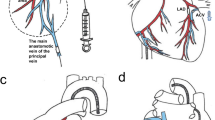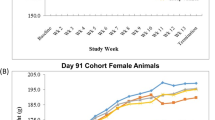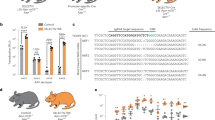Abstract
High-efficiency somatic gene transfer in adult mouse heart has not yet been achieved in vivo. Here, we demonstrate high-efficiency in vivo transcoronary gene delivery to the adult murine myocardium using a catheter-based technique with recombinant adenovirus (AdV) and adeno-associated virus (AAV) vectors in normal and genetically engineered mice. The method involves immersion hypothermia followed by transient aortic and pulmonary artery occlusion with proximal intra-aortic segmental injection of cardioplegic solution containing substance P and viral vectors. Gene expression measured using a LacZ marker gene was observed throughout both ventricles. The expression efficiency of a cytoplasmic LacZ marker gene in the left ventricular myocardium was 56.4±14.5% (mean±s.d.) at 4 days with an AdV vector, and with an AAV vector it was 81.0±5.9% at 4 weeks. Following AAV gene transfer, no gene expression was found in kidney, brain, lung, and spleen, but there was slight expression in liver. In addition, we demonstrate temporally controlled genetic manipulation in the heart with an efficiency of 54.6±5.2%, by transferring an AdV vector carrying Cre recombinase in ROSA26 flox-LacZ reporter mice. Procedure-related mortality was 16% for AdV and zero for AAV transfer. Thus, this method provides efficient, relatively homogeneous gene expression in both ventricles of the adult mouse heart, and offers a novel approach for conditional gene rescue or ablation in genetically engineered mouse models.
This is a preview of subscription content, access via your institution
Access options
Subscribe to this journal
Receive 12 print issues and online access
$259.00 per year
only $21.58 per issue
Buy this article
- Purchase on Springer Link
- Instant access to full article PDF
Prices may be subject to local taxes which are calculated during checkout




Similar content being viewed by others
References
Ikeda Y, Ross Jr J . Models of dilated cardiomyopathy in the mouse and the hamster. Curr Opin Cardiol 2000; 15: 197–201.
Ross Jr J . Dilated cardiomyopathy: concepts derived from gene deficient and transgenic animal models. Circ J 2002; 66: 219–224.
Towbin JA, Bowles NE . The failing heart. Nature 2002; 415: 227–233.
Minamisawa S et al. Chronic phospholamban-sarcoplasmic reticulum calcium ATPase interaction is the critical calcium cycling defect in dilated cardiomyopathy. Cell 1999; 99: 313–322.
Balling R . ENU mutagenesis: analyzing gene function in mice. Annu Rev Genom Hum Genet 2001; 2: 463–492.
Suzuki M, Carlson KM, Marchuk DA, Rockman HA . Genetic modifier loci affecting survival and cardiac function in murine dilated cardiomyopathy. Circulation 2002; 105: 1824–1829.
Christensen G et al. High-efficiency, long-term cardiac expression of foreign genes in living mouse embryos and neonates. Circulation 2000; 101: 178–184.
Su H, Lu R, Kan YW . Adeno-associated viral vector-mediated vascular endothelial growth factor gene transfer induces neovascular formation in ischemic heart. Proc Natl Acad Sci USA 2000; 97: 13801–13806.
Stratford-Perricaudet LD, Makeh I, Perricaudet M, Briand P . Widespread long-term gene transfer to mouse skeletal muscles and heart. J Clin Invest 1992; 90: 626–630.
Svensson EC et al. Efficient and stable transduction of cardiomyocytes after intramyocardial injection or intracoronary perfusion with recombinant adeno-associated virus vectors. Circulation 1999; 99: 201–205.
Agah R et al. Gene recombination in postmitotic cells. Targeted expression of Cre recombinase provokes cardiac-restricted, site-specific rearrangement in adult ventricular muscle in vivo. J Clin Invest 1997; 100: 169–179.
Hajjar RJ et al. Modulation of ventricular function through gene transfer in vivo. Proc Natl Acad Sci USA 1998; 95: 5251–5256.
Maurice JP et al. Enhancement of cardiac function after adenoviral-mediated in vivo intracoronary beta2-adrenergic receptor gene delivery. J Clin Invest 1999; 104: 21–29.
Liao P et al. The in vivo role of p38 MAP kinases in cardiac remodeling and restrictive cardiomyopathy. Proc Natl Acad Sci USA 2001; 98: 12283–12288.
Chen J, Kubalak SW, Chien KR . Ventricular muscle-restricted targeting of the RXRalpha gene reveals a non-cell-autonomous requirement in cardiac chamber morphogenesis. Development 1998; 125: 1943–1949.
Hirota H et al. Loss of a gp130 cardiac muscle cell survival pathway is a critical event in the onset of heart failure during biomechanical stress. Cell 1999; 97: 189–198.
Soriano P . Generalized lacZ expression with the ROSA26 Cre reporter strain. Nat Genet 1999; 21: 70–71.
Ikeda Y et al. Restoration of deficient membrane proteins in the cardiomyopathic hamster by in vivo cardiac gene transfer. Circulation 2002; 105: 502–508.
Hoshijima M et al. Chronic suppression of heart-failure progression by a pseudophosphorylated mutant of phospho-lamban via in vivo cardiac rAAV gene delivery. Nat Med 2002; 8: 864–871.
Tanaka N et al. Transthoracic echocardiography in models of cardiac disease in the mouse. Circulation 1996; 94: 1109–1117.
Arber S et al. MLP-deficient mice exhibit a disruption of cardiac cytoarchitectural organization, dilated cardiomyopathy, and heart failure. Cell 1997; 88: 393–403.
Palakodeti V et al. Force–frequency effect is a powerful determinant of myocardial contractility in the mouse. Am J Physiol 1997; 273: H1283–1290.
Luo Y et al. Rescuing the N-cadherin knockout by cardiac-specific expression of N- or E-cadherin. Development 2001; 128: 459–469.
Subramaniam A et al. Tissue-specific regulation of the alpha-myosin heavy chain gene promoter in transgenic mice. J Biol Chem 1991; 266: 24613–24620.
Huang WY, Aramburu J, Douglas PS, Izumo S . Transgenic expression of green fluorescence protein can cause dilated cardiomyopathy. Nat Med 2000; 6: 482–483.
Fishman GI . Timing is everything in life: conditional transgene expression in the cardiovascular system. Circ Res 1998; 82: 837–844.
Sohal DS et al. Temporally regulated and tissue-specific gene manipulations in the adult and embryonic heart using a tamoxifen-inducible Cre protein. Circ Res 2001; 89:20–25.
Minamino T, Gaussin V, DeMayo FJ, Schneider MD . Inducible gene targeting in postnatal myocardium by cardiac-specific expression of a hormone-activated Cre fusion protein. Circ Res 2001; 88: 587–592.
Stanley EG et al. Efficient Cre-mediated deletion in cardiac progenitor cells conferred by a 3'UTR-ires-Cre allele of the homeobox gene Nkx2-5. Int J Dev Biol 2002; 46: 431–439.
Nagy A . Cre recombinase: the universal reagent for genome tailoring. Genesis 2000; 26: 99–109.
Lewandoski M . Conditional control of gene expression in the mouse. Nat Rev Genet 2001; 2: 743–755.
Metzger D, Chambon P . Site- and time-specific gene targeting in the mouse. Methods 2001; 24: 71–80.
Baluk P et al. Endothelial gaps: time course of formation and closure in inflamed venules of rats. Am J Physiol 1997; 272: L155–L170.
Gomez-Foix AM et al. Adenovirus-mediated transfer of the muscle glycogen phosphorylase gene into hepatocytes confers altered regulation of glycogen metabolism. J Biol Chem 1992; 267: 25129–25134.
Xiao X, Li J, Samulski RJ . Production of high-titer recombinant adeno-associated virus vectors in the absence of helper adenovirus. J Virol 1998; 72: 2224–2232.
Auricchio A et al. Isolation of highly infectious and pure adeno-associated virus type 2 vectors with a single-step gravity-flow column. Hum Gene Ther 2001; 12: 71–76.
Acknowledgements
This study was supported by Jean LeDucq foundation, the Richard D Winter Fund, the Perlman Cardiovascular Research Fund, and by HL46345 from the National Heart Lung and Blood Institute (KC). TD was funded by grants from the Swiss National Science Foundation (81BS-64528) and the Freiwillige Akademische Gesellschaft Basel, Switzerland. We thank J Chrast for technical help.
Author information
Authors and Affiliations
Additional information
The first two authors contributed equally to this work
Rights and permissions
About this article
Cite this article
Iwatate, M., Gu, Y., Dieterle, T. et al. In vivo high-efficiency transcoronary gene delivery and Cre–LoxP gene switching in the adult mouse heart. Gene Ther 10, 1814–1820 (2003). https://doi.org/10.1038/sj.gt.3302077
Received:
Accepted:
Published:
Issue Date:
DOI: https://doi.org/10.1038/sj.gt.3302077
Keywords
This article is cited by
-
Robust cardiomyocyte-specific gene expression following systemic injection of AAV: in vivo gene delivery follows a Poisson distribution
Gene Therapy (2011)
-
MicroRNA-133 controls cardiac hypertrophy
Nature Medicine (2007)
-
Efficient, cardiac-specific adenoviral gene transfer in rat heart by isolated retrograde perfusion in vivo
Gene Therapy (2005)



